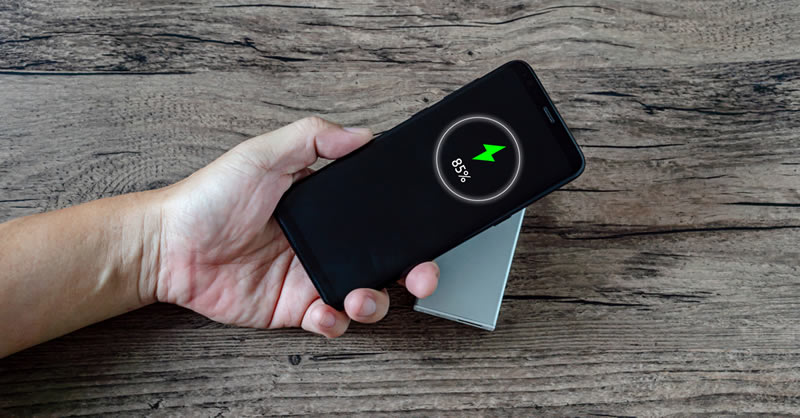
If you’ve ever looked at the specs for a smartphone, then alongside wired charging and wireless charging you might have noticed something called reverse wireless charging listed.
Or you might have seen Wireless Powershare mentioned (if you’re using a Samsung phone) or Battery Share (on a Google Pixel). These are all different names for the same thing, but what is reverse wireless charging? Which phones have it? And is it worth using?
We’ll answer all of that below, so you can make the most of the charging options on your handset.
What is reverse wireless charging?
Reverse wireless charging is a tech that allows you to use your phone as a wireless charging pad for other devices.
So with this you could for example place a smartwatch on the back of your phone, and it would be charged up by your phone wirelessly transferring some of its stored battery power to the smartwatch.
In the process you’ll be reducing your phone’s battery level of course, but as a smartphone typically has a far higher maximum battery capacity than the likes of a smartwatch, it shouldn’t make too much of a dent – or you could have your phone plugged in and charging at the same time.
How fast is reverse wireless charging?
The speed of reverse wireless charging varies from phone to phone, but generally it’s very slow, with even the super-premium Samsung Galaxy S24 Ultra being limited to 4.5W of power.
You don’t need to spend top end money for reverse wireless charging though, or to top those speeds, with the mid-range Nothing Phone 2 for example offering 5W reverse wireless charging, but whatever handset you choose it will be slow.
For reference, the Nothing Phone 2 offers 45W wired charging and 15W wireless charging, and the Galaxy S24 Ultra also offers 45W wired charging and 15W wireless, but some phones can manage much more, with the Xiaomi 14 Ultra for example offering 90W wired charging and 80W wireless. That does at least get up to 10W with reverse wireless charging, which is better than most, but in all cases there’s a massive gulf between reverse wireless charging speeds and standard charging.
What can you charge with reverse wireless charging?
Reverse wireless charging typically supports all devices that work with Qi wireless charging, which includes many smartphones, smartwatches, headphones, and earbuds.
However, given the very slow charging speed and the fact that you’ll be using your phone’s own battery to juice up these devices, it’s best for things that have small batteries – think smartwatches and earbuds rather than smartphones.
Does the iPhone 16 have reverse wireless charging?
No, the iPhone 16 doesn’t offer reverse wireless charging and nor does any other iPhone. However, you can use reverse wired charging with the iPhone 16 range – that means plugging one end of a cable into your iPhone 16 and the other into the device you want to charge.
Which phones do support reverse wireless charging?
A large number of phones support reverse wireless charging. Key Samsung handsets with this feature include the Samsung Galaxy S24, Samsung Galaxy S24 Plus, Samsung Galaxy S24 Ultra, Samsung Galaxy S23 series, the Galaxy S22 series, the Galaxy S21 line, the Samsung Galaxy Z Fold 6, the Samsung Galaxy Z Fold 5, the Samsung Galaxy Z Fold 4, the Samsung Galaxy Z Flip 6, the Samsung Galaxy Z Flip 5, the Samsung Galaxy Z Flip 4, the Galaxy Z Flip 3, and the Galaxy Z Fold 3.
Google meanwhile offers reverse wireless charging on the Pixel 9, the Pixel 9 Pro, the Pixel 9 Pro XL, the Pixel 8, the Pixel 8 Pro, the Pixel 7, the Pixel 7 Pro, the Pixel 6 Pro, and the Pixel 6.
With Xiaomi, you can get reverse wireless charging on the likes of the Xiaomi 15, Xiaomi 15 Pro, Xiaomi 14, Xiaomi 14 Pro, Xiaomi 14 Ultra, Xiaomi 13, the Xiaomi 13 Pro, the Xiaomi 13 Ultra, the Xiaomi 12 Pro, the Xiaomi 12S Ultra, and the Xiaomi Mi 11 Ultra, among other Xiaomi phones.
It’s also available on a selection of other handsets, such as the OnePlus 13, the Nothing Phone 2, and the Sony Xperia 1 VI.
So reverse wireless charging is a fairly common feature, especially on high-end phones, but it’s far from standard.
Is reverse wireless charging worthwhile?
For most people, we wouldn’t suggest placing much importance on reverse wireless charging when choosing which phone to buy. It’s a niche feature that probably won’t be used much by most smartphone owners.
Given the slow speed, it’s rarely as useful as a dedicated wireless charger. But if you don’t have such a charger accessible and you have an important device that’s about to run out of battery, then it could be a handy tool to have at your disposal.









